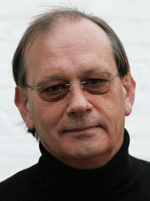© University of Kent - Contact | Feedback | Legal | FOI | Cookies
Bridging Art and Science: Little Pictures and Bigger Ones
A joint research event between the Centre for Cognitive Neuroscience and Cognitive Systems and the Centre for Cognition,
Kinesthetics and Performance
27 March, 4.15pm
Computing, University of Kent, Canterbury Philip Barnard, Scientific Advisor at Wayne McGregor Random Dance and Visiting Scientist, MRC Cognition and Brain Sciences Unit
Philip Barnard, Scientific Advisor at Wayne McGregor Random Dance and Visiting Scientist, MRC Cognition and Brain Sciences Unit discusses the relationship between the arts and sciences in his work.
Relationships between art and science have always been intricate – philosophers, scientists and cognitive archaeologists have wondered at, and debated the nature and origins of human innovation and creativity. Scientists have used their kind of systematic and hard data about perception, thought, language, meaning, emotion and social interactions to elucidate the workings of the creative arts and how they affect the minds of individuals and groups. Equally artists have been inspired by, and can draw upon all sorts of different technologies and scientific ideas in the process of making an artwork. This talk will summarise and draw upon a decade-long collaboration between the Choreographer Wayne McGregor and cognitive science and cognitive neuroscience. It will show examples of little pictures – pieces of evidence about the thinking of choreographers and dancers – particularly on the roles of variation in the use of imagery. It will also set these little pictures in the context of three classes of "bigger" pictures that address the inferential problems of linking ideas about brains, minds and behaviours, how bridges are built and used between sources of inspiration and artworks and how the processes of artistic innovation in the generation of a specific artwork unfold over time. It will conclude by providing two examples of how understandings these bigger pictures can support the augmentation of artistic processes, not only for the artistic elite but also in the classroom.
Philip Barnard
Philip Barnard worked at the Medical Research Council's Cognition and Brain Sciences Unit (formerly the Applied Psychology Unit) in Cambridge from 1972 to 2011. Over the course of his career, he has carried out research on how memory, attention, language, body states and emotion work together in the normal healthy, human mind. He is committed to seeing the types of basic cognitive theory developed in scientific laboratories put to good use in the real world. His theoretical model of the architecture of the human mind has been applied to the problems of designing 'easy to use' everyday technologies and computer interfaces. He has applied the same theory to help understand and treat emotional disorders like depression, as well using it to account for the way in which human mental and emotional skills have developed over the long-term course of evolution. Dance shares with these other areas of interest an intricate blending of intellectual, communicative, physical and emotional skills. Since 2003, Philip has been collaborating with Wayne McGregor | Random Dance on interdisciplinary research projects with the aim of developing productive synergies between choreographic processes and our knowledge of cognitive neuroscience.